Developing a Leadership Development Plan Based on Johari Window Model
VerifiedAdded on 2023/05/29
|18
|4752
|288
AI Summary
This report focuses on the development of a leadership development plan based on Johari window model of leadership development. It discusses the various leadership development models and the best model suitable for the individual. It also provides insights on the Johari Window Model, intentional change model theory and the GROW model for structuring coaching.
Contribute Materials
Your contribution can guide someone’s learning journey. Share your
documents today.

Running head: DYNAMIC LEADERSHIP
Dynamic Leadership
Name of student:
Name of college:
Authors note:
1
Dynamic Leadership
Name of student:
Name of college:
Authors note:
1
Secure Best Marks with AI Grader
Need help grading? Try our AI Grader for instant feedback on your assignments.
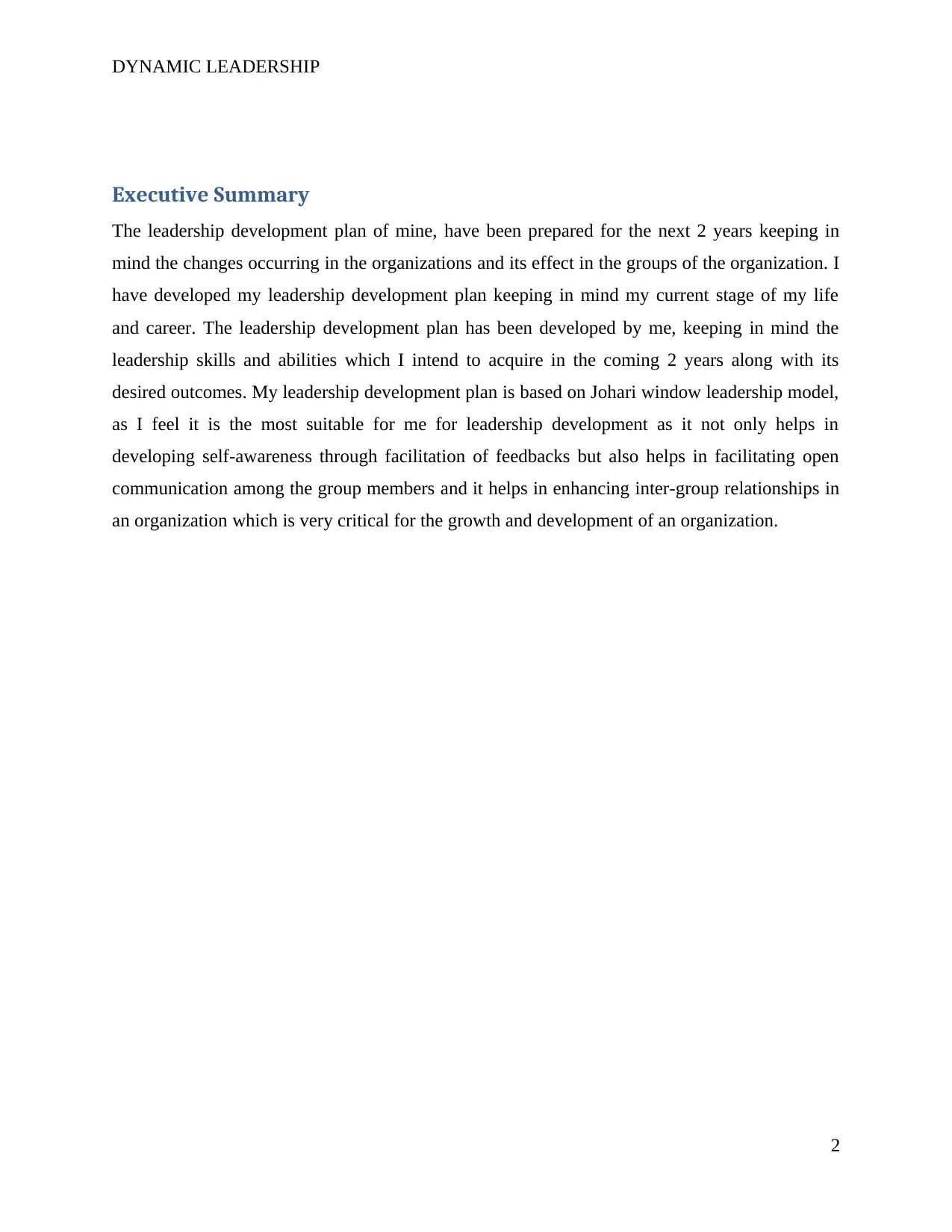
DYNAMIC LEADERSHIP
Executive Summary
The leadership development plan of mine, have been prepared for the next 2 years keeping in
mind the changes occurring in the organizations and its effect in the groups of the organization. I
have developed my leadership development plan keeping in mind my current stage of my life
and career. The leadership development plan has been developed by me, keeping in mind the
leadership skills and abilities which I intend to acquire in the coming 2 years along with its
desired outcomes. My leadership development plan is based on Johari window leadership model,
as I feel it is the most suitable for me for leadership development as it not only helps in
developing self-awareness through facilitation of feedbacks but also helps in facilitating open
communication among the group members and it helps in enhancing inter-group relationships in
an organization which is very critical for the growth and development of an organization.
2
Executive Summary
The leadership development plan of mine, have been prepared for the next 2 years keeping in
mind the changes occurring in the organizations and its effect in the groups of the organization. I
have developed my leadership development plan keeping in mind my current stage of my life
and career. The leadership development plan has been developed by me, keeping in mind the
leadership skills and abilities which I intend to acquire in the coming 2 years along with its
desired outcomes. My leadership development plan is based on Johari window leadership model,
as I feel it is the most suitable for me for leadership development as it not only helps in
developing self-awareness through facilitation of feedbacks but also helps in facilitating open
communication among the group members and it helps in enhancing inter-group relationships in
an organization which is very critical for the growth and development of an organization.
2
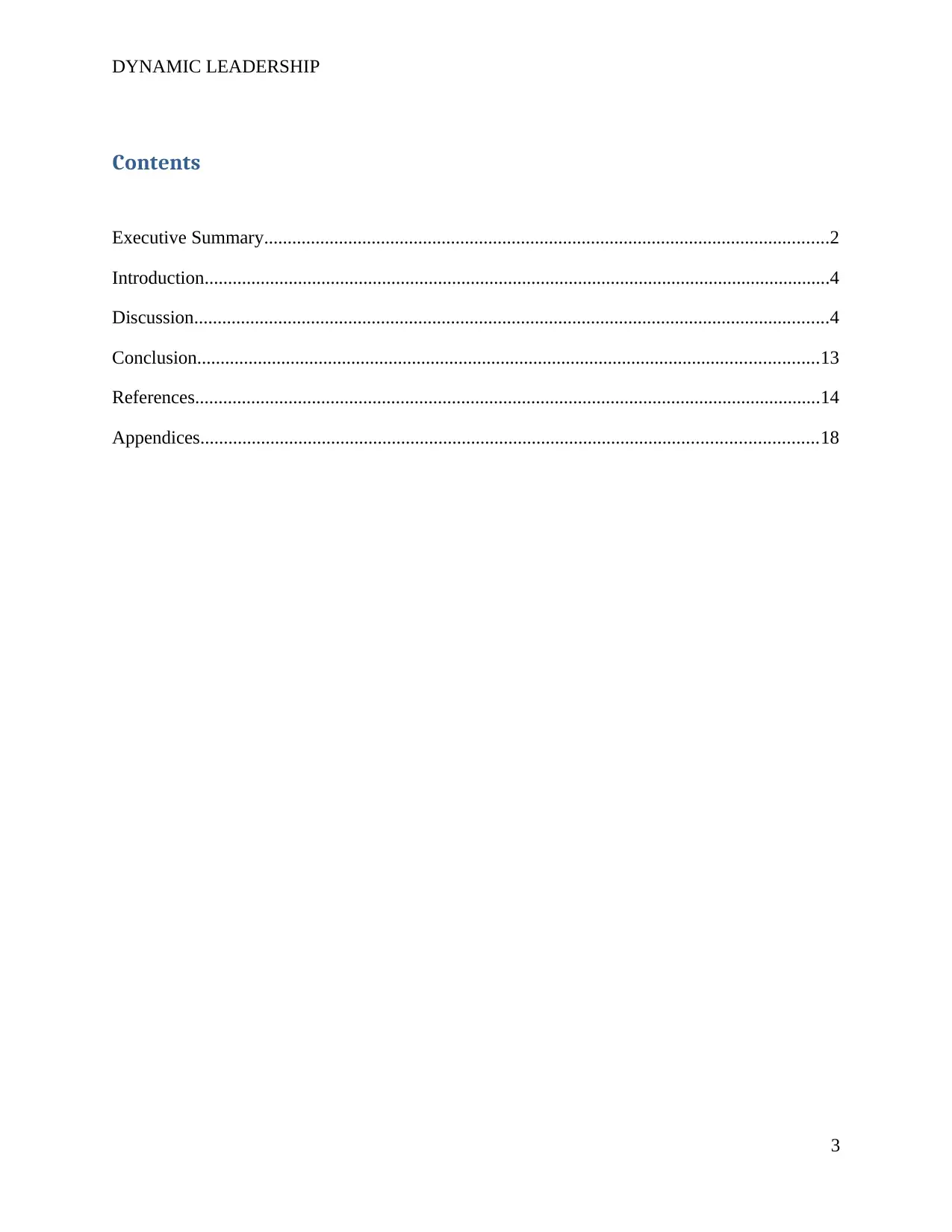
DYNAMIC LEADERSHIP
Contents
Executive Summary.........................................................................................................................2
Introduction......................................................................................................................................4
Discussion........................................................................................................................................4
Conclusion.....................................................................................................................................13
References......................................................................................................................................14
Appendices....................................................................................................................................18
3
Contents
Executive Summary.........................................................................................................................2
Introduction......................................................................................................................................4
Discussion........................................................................................................................................4
Conclusion.....................................................................................................................................13
References......................................................................................................................................14
Appendices....................................................................................................................................18
3
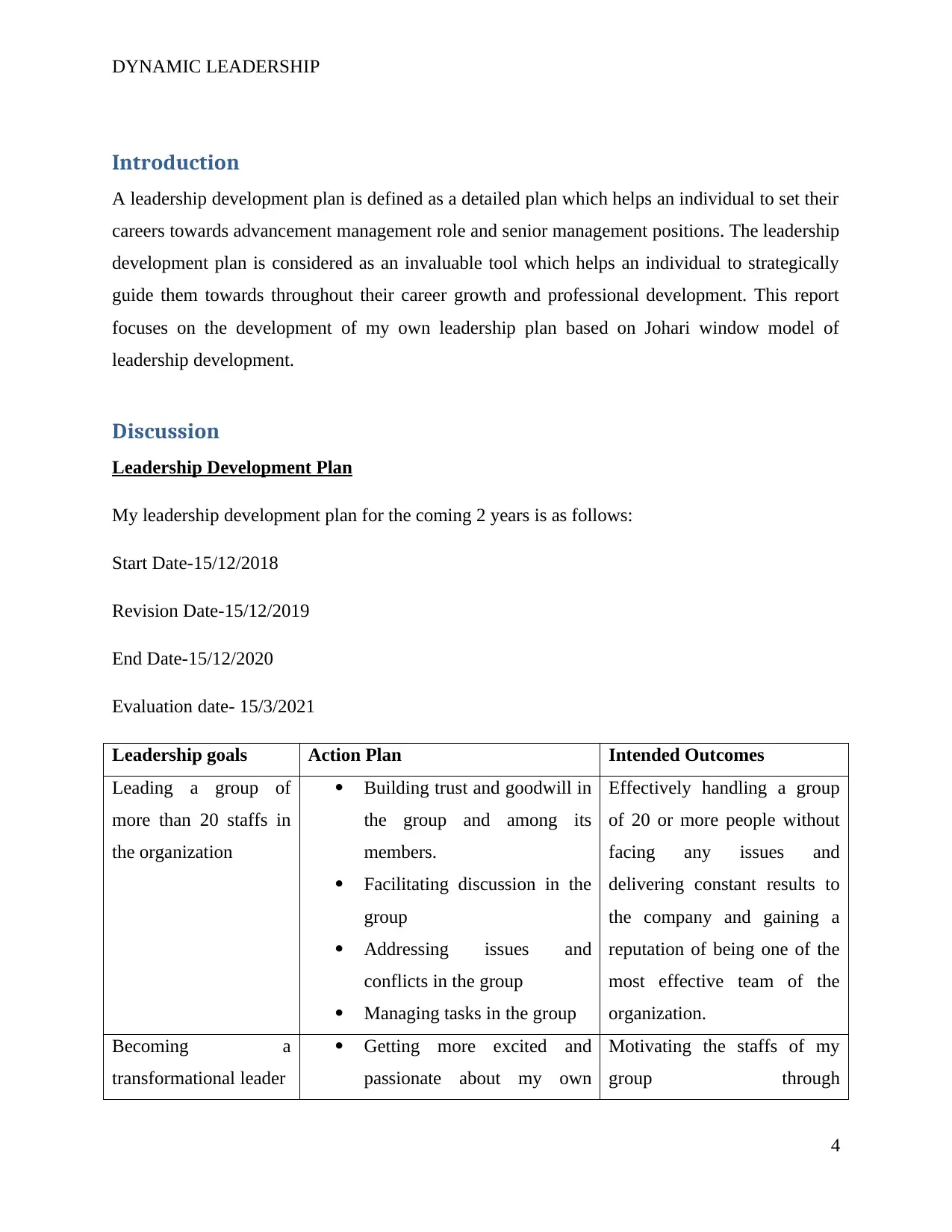
DYNAMIC LEADERSHIP
Introduction
A leadership development plan is defined as a detailed plan which helps an individual to set their
careers towards advancement management role and senior management positions. The leadership
development plan is considered as an invaluable tool which helps an individual to strategically
guide them towards throughout their career growth and professional development. This report
focuses on the development of my own leadership plan based on Johari window model of
leadership development.
Discussion
Leadership Development Plan
My leadership development plan for the coming 2 years is as follows:
Start Date-15/12/2018
Revision Date-15/12/2019
End Date-15/12/2020
Evaluation date- 15/3/2021
Leadership goals Action Plan Intended Outcomes
Leading a group of
more than 20 staffs in
the organization
Building trust and goodwill in
the group and among its
members.
Facilitating discussion in the
group
Addressing issues and
conflicts in the group
Managing tasks in the group
Effectively handling a group
of 20 or more people without
facing any issues and
delivering constant results to
the company and gaining a
reputation of being one of the
most effective team of the
organization.
Becoming a
transformational leader
Getting more excited and
passionate about my own
Motivating the staffs of my
group through
4
Introduction
A leadership development plan is defined as a detailed plan which helps an individual to set their
careers towards advancement management role and senior management positions. The leadership
development plan is considered as an invaluable tool which helps an individual to strategically
guide them towards throughout their career growth and professional development. This report
focuses on the development of my own leadership plan based on Johari window model of
leadership development.
Discussion
Leadership Development Plan
My leadership development plan for the coming 2 years is as follows:
Start Date-15/12/2018
Revision Date-15/12/2019
End Date-15/12/2020
Evaluation date- 15/3/2021
Leadership goals Action Plan Intended Outcomes
Leading a group of
more than 20 staffs in
the organization
Building trust and goodwill in
the group and among its
members.
Facilitating discussion in the
group
Addressing issues and
conflicts in the group
Managing tasks in the group
Effectively handling a group
of 20 or more people without
facing any issues and
delivering constant results to
the company and gaining a
reputation of being one of the
most effective team of the
organization.
Becoming a
transformational leader
Getting more excited and
passionate about my own
Motivating the staffs of my
group through
4
Secure Best Marks with AI Grader
Need help grading? Try our AI Grader for instant feedback on your assignments.
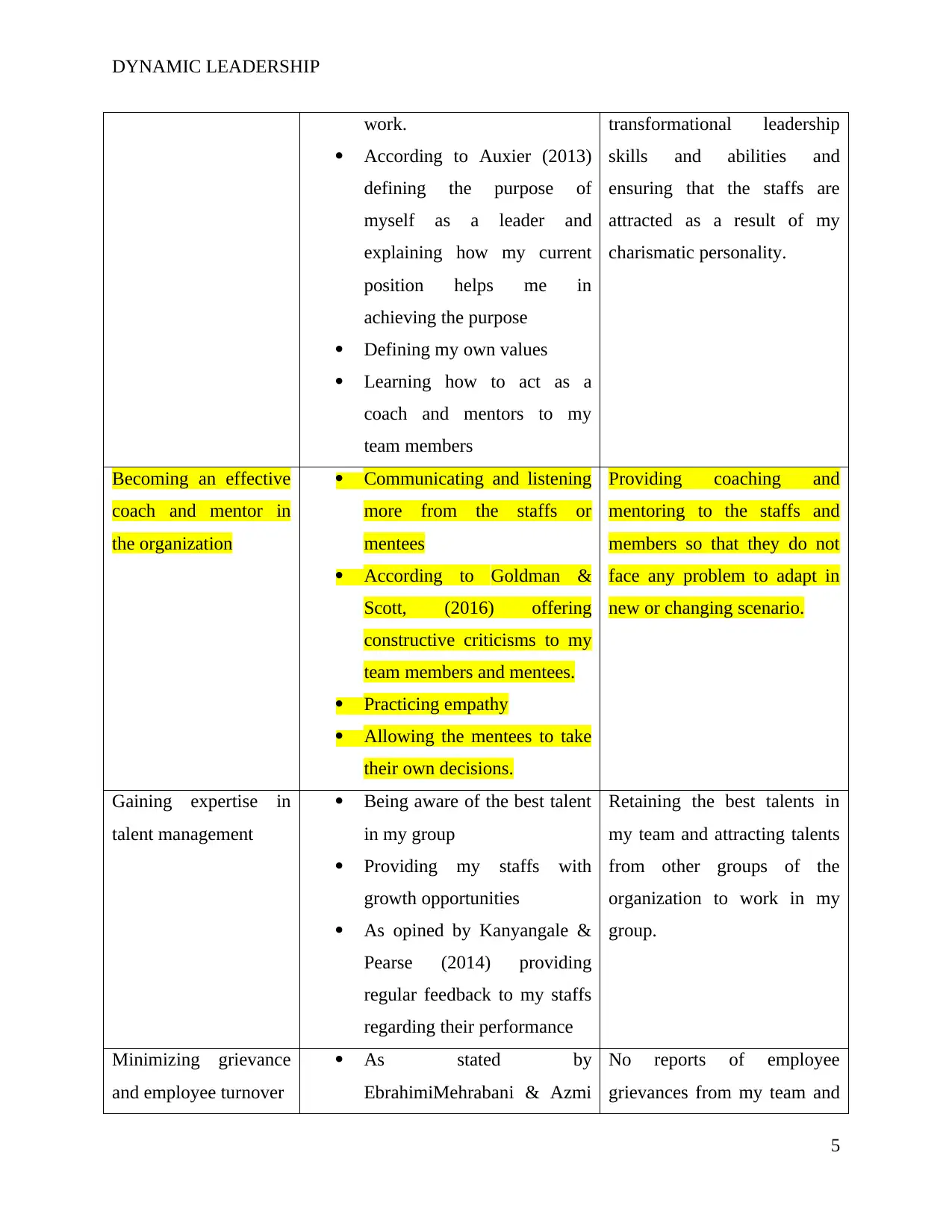
DYNAMIC LEADERSHIP
work.
According to Auxier (2013)
defining the purpose of
myself as a leader and
explaining how my current
position helps me in
achieving the purpose
Defining my own values
Learning how to act as a
coach and mentors to my
team members
transformational leadership
skills and abilities and
ensuring that the staffs are
attracted as a result of my
charismatic personality.
Becoming an effective
coach and mentor in
the organization
Communicating and listening
more from the staffs or
mentees
According to Goldman &
Scott, (2016) offering
constructive criticisms to my
team members and mentees.
Practicing empathy
Allowing the mentees to take
their own decisions.
Providing coaching and
mentoring to the staffs and
members so that they do not
face any problem to adapt in
new or changing scenario.
Gaining expertise in
talent management
Being aware of the best talent
in my group
Providing my staffs with
growth opportunities
As opined by Kanyangale &
Pearse (2014) providing
regular feedback to my staffs
regarding their performance
Retaining the best talents in
my team and attracting talents
from other groups of the
organization to work in my
group.
Minimizing grievance
and employee turnover
As stated by
EbrahimiMehrabani & Azmi
No reports of employee
grievances from my team and
5
work.
According to Auxier (2013)
defining the purpose of
myself as a leader and
explaining how my current
position helps me in
achieving the purpose
Defining my own values
Learning how to act as a
coach and mentors to my
team members
transformational leadership
skills and abilities and
ensuring that the staffs are
attracted as a result of my
charismatic personality.
Becoming an effective
coach and mentor in
the organization
Communicating and listening
more from the staffs or
mentees
According to Goldman &
Scott, (2016) offering
constructive criticisms to my
team members and mentees.
Practicing empathy
Allowing the mentees to take
their own decisions.
Providing coaching and
mentoring to the staffs and
members so that they do not
face any problem to adapt in
new or changing scenario.
Gaining expertise in
talent management
Being aware of the best talent
in my group
Providing my staffs with
growth opportunities
As opined by Kanyangale &
Pearse (2014) providing
regular feedback to my staffs
regarding their performance
Retaining the best talents in
my team and attracting talents
from other groups of the
organization to work in my
group.
Minimizing grievance
and employee turnover
As stated by
EbrahimiMehrabani & Azmi
No reports of employee
grievances from my team and
5
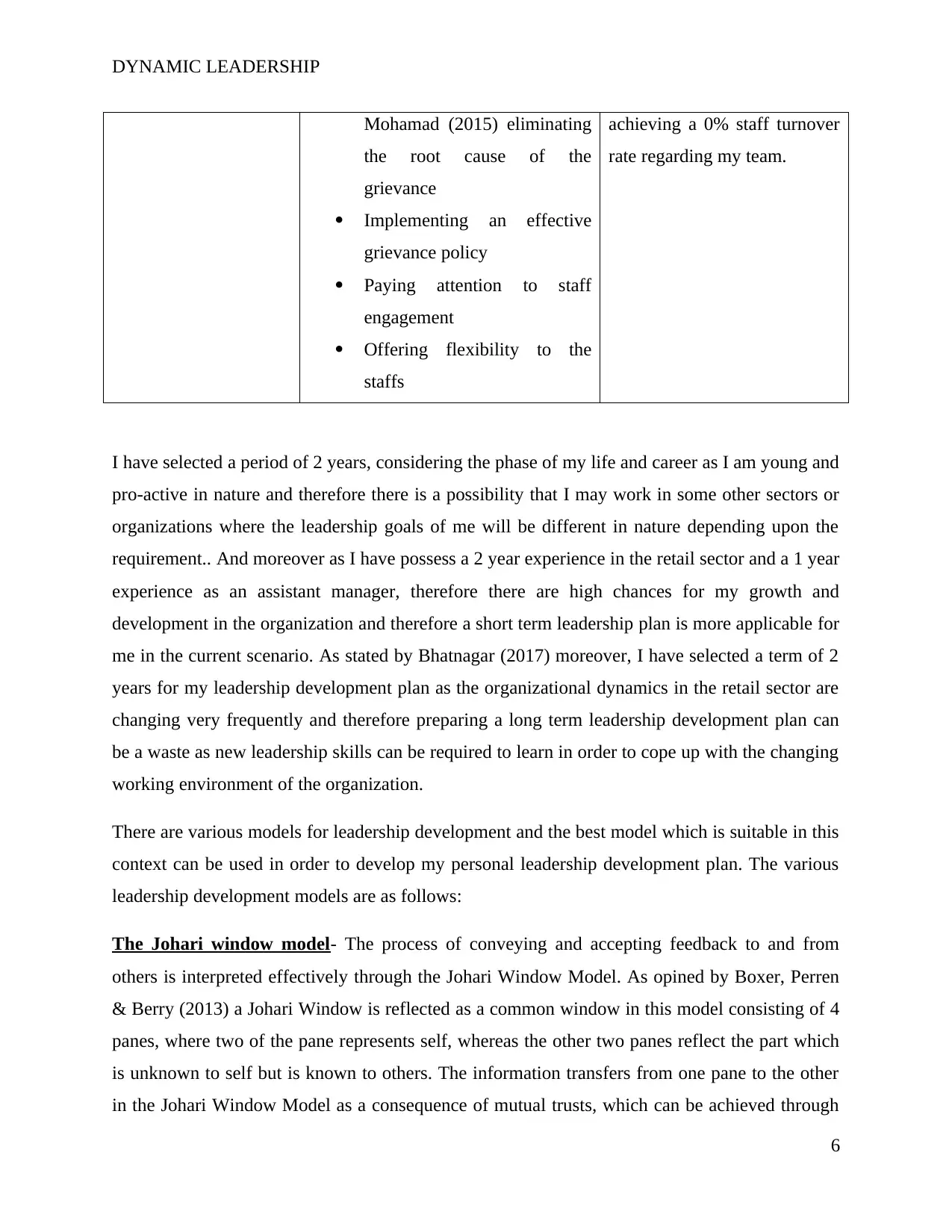
DYNAMIC LEADERSHIP
Mohamad (2015) eliminating
the root cause of the
grievance
Implementing an effective
grievance policy
Paying attention to staff
engagement
Offering flexibility to the
staffs
achieving a 0% staff turnover
rate regarding my team.
I have selected a period of 2 years, considering the phase of my life and career as I am young and
pro-active in nature and therefore there is a possibility that I may work in some other sectors or
organizations where the leadership goals of me will be different in nature depending upon the
requirement.. And moreover as I have possess a 2 year experience in the retail sector and a 1 year
experience as an assistant manager, therefore there are high chances for my growth and
development in the organization and therefore a short term leadership plan is more applicable for
me in the current scenario. As stated by Bhatnagar (2017) moreover, I have selected a term of 2
years for my leadership development plan as the organizational dynamics in the retail sector are
changing very frequently and therefore preparing a long term leadership development plan can
be a waste as new leadership skills can be required to learn in order to cope up with the changing
working environment of the organization.
There are various models for leadership development and the best model which is suitable in this
context can be used in order to develop my personal leadership development plan. The various
leadership development models are as follows:
The Johari window model- The process of conveying and accepting feedback to and from
others is interpreted effectively through the Johari Window Model. As opined by Boxer, Perren
& Berry (2013) a Johari Window is reflected as a common window in this model consisting of 4
panes, where two of the pane represents self, whereas the other two panes reflect the part which
is unknown to self but is known to others. The information transfers from one pane to the other
in the Johari Window Model as a consequence of mutual trusts, which can be achieved through
6
Mohamad (2015) eliminating
the root cause of the
grievance
Implementing an effective
grievance policy
Paying attention to staff
engagement
Offering flexibility to the
staffs
achieving a 0% staff turnover
rate regarding my team.
I have selected a period of 2 years, considering the phase of my life and career as I am young and
pro-active in nature and therefore there is a possibility that I may work in some other sectors or
organizations where the leadership goals of me will be different in nature depending upon the
requirement.. And moreover as I have possess a 2 year experience in the retail sector and a 1 year
experience as an assistant manager, therefore there are high chances for my growth and
development in the organization and therefore a short term leadership plan is more applicable for
me in the current scenario. As stated by Bhatnagar (2017) moreover, I have selected a term of 2
years for my leadership development plan as the organizational dynamics in the retail sector are
changing very frequently and therefore preparing a long term leadership development plan can
be a waste as new leadership skills can be required to learn in order to cope up with the changing
working environment of the organization.
There are various models for leadership development and the best model which is suitable in this
context can be used in order to develop my personal leadership development plan. The various
leadership development models are as follows:
The Johari window model- The process of conveying and accepting feedback to and from
others is interpreted effectively through the Johari Window Model. As opined by Boxer, Perren
& Berry (2013) a Johari Window is reflected as a common window in this model consisting of 4
panes, where two of the pane represents self, whereas the other two panes reflect the part which
is unknown to self but is known to others. The information transfers from one pane to the other
in the Johari Window Model as a consequence of mutual trusts, which can be achieved through
6
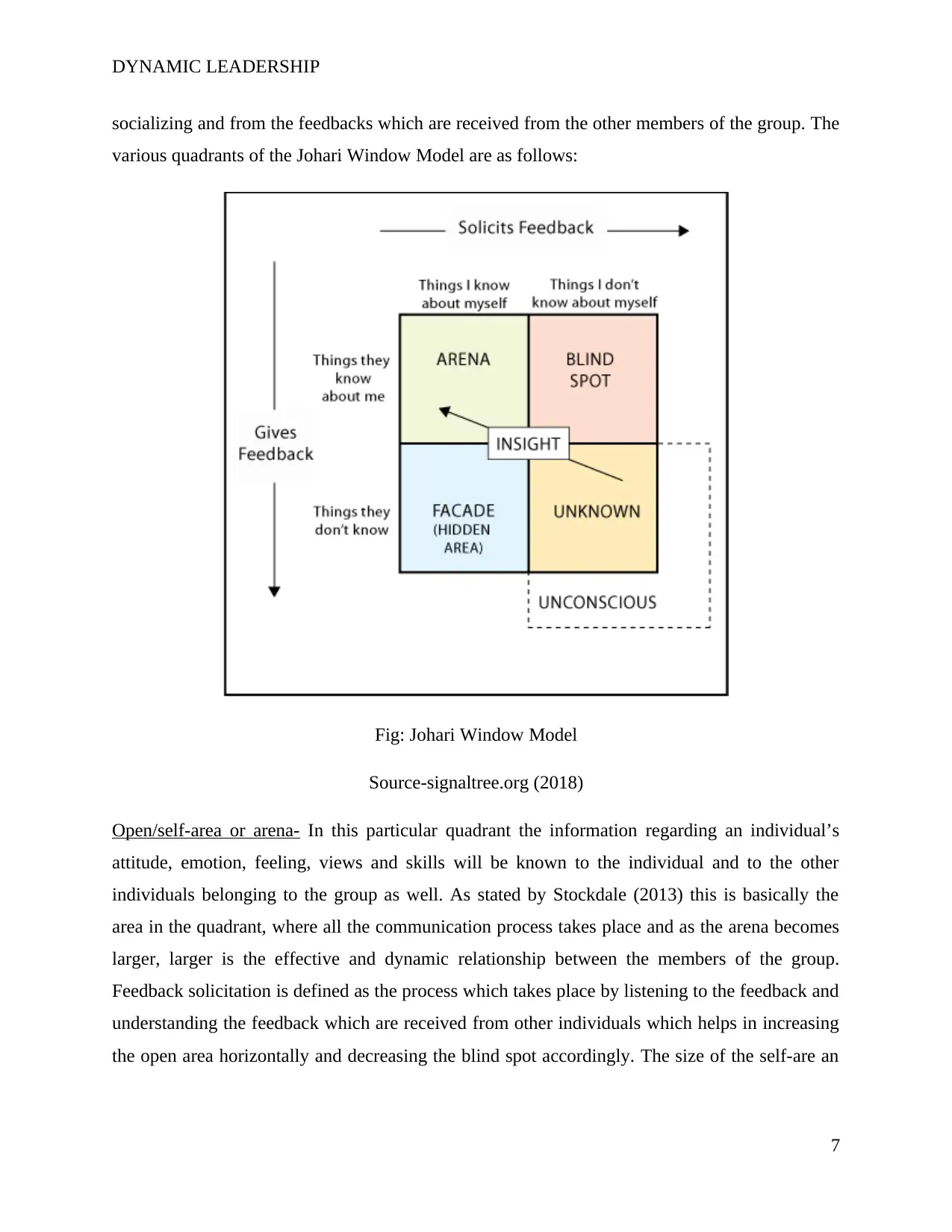
DYNAMIC LEADERSHIP
socializing and from the feedbacks which are received from the other members of the group. The
various quadrants of the Johari Window Model are as follows:
Fig: Johari Window Model
Source-signaltree.org (2018)
Open/self-area or arena- In this particular quadrant the information regarding an individual’s
attitude, emotion, feeling, views and skills will be known to the individual and to the other
individuals belonging to the group as well. As stated by Stockdale (2013) this is basically the
area in the quadrant, where all the communication process takes place and as the arena becomes
larger, larger is the effective and dynamic relationship between the members of the group.
Feedback solicitation is defined as the process which takes place by listening to the feedback and
understanding the feedback which are received from other individuals which helps in increasing
the open area horizontally and decreasing the blind spot accordingly. The size of the self-are an
7
socializing and from the feedbacks which are received from the other members of the group. The
various quadrants of the Johari Window Model are as follows:
Fig: Johari Window Model
Source-signaltree.org (2018)
Open/self-area or arena- In this particular quadrant the information regarding an individual’s
attitude, emotion, feeling, views and skills will be known to the individual and to the other
individuals belonging to the group as well. As stated by Stockdale (2013) this is basically the
area in the quadrant, where all the communication process takes place and as the arena becomes
larger, larger is the effective and dynamic relationship between the members of the group.
Feedback solicitation is defined as the process which takes place by listening to the feedback and
understanding the feedback which are received from other individuals which helps in increasing
the open area horizontally and decreasing the blind spot accordingly. The size of the self-are an
7
Paraphrase This Document
Need a fresh take? Get an instant paraphrase of this document with our AI Paraphraser

DYNAMIC LEADERSHIP
also be increased in a downwards manner, which helps in decreasing the hidden and unknown
areas by exposing the feeling of one individual to the other individuals in the group.
Blind-self or blind spot- As stated by Adizes, Cudanov & Rodic (2017) the blind-self or the blind
spot is the area of the quadrant where information about oneself is unknown to self, but it is
known to the other individuals belonging to the group as others may interpret an individual in a
different perspective from oneself. The blind spot can be reduced by enhancing the
communication process in the group and by seeking feedback about oneself from the group.
Hidden area or façade- The quadrant of the Johari window model which contains information
about an individual which is known to the individual but is unknown to other members of the
group is termed as hidden area or façade. As stated by Buckwell-Nutt, Francis-Shama & Kellett
(2014) the information which is basically found in the hidden area is personal information which
an individual feels reluctant to share with other individuals of the group such as feelings, past
experiences, fear, secrets etc. As stated by Berland (2017) every individual keep some
information about themselves as private and do not tend to discuss with other individuals as they
perceive that, disclosure of such personal information affects the relationships between the
individuals. The hidden area of the Johari window model can be reduced by moving information
to the open area of the model.
Unknown area- The information about an individual such as feelings, capabilities and talents of
an individual which are unknown to the individual and also unknown to the other individuals of
the group falls in the unknown area quadrant of the Johari window model. As stated by Glew &
Harper (2018) the reason for lack of information about an individual to the individual and to
other individuals can be due to traumatic past experiences or events which can be unknown for a
lifetime to an individual and to other individuals as well. The individual will tend to remain
unaware about his hidden qualities and capabilities until and unless he discovers it by himself or
through observation of others. Open communication is an effective process which can be used to
reduce the unknown area of an individual so that the hidden capabilities and qualities of the
individuals get noticed by other individuals.
Intentional Change model- The intentional change model theory was developed by Richard
Boyatzis, as a part of his work on individual and organizational change. The intentional change
8
also be increased in a downwards manner, which helps in decreasing the hidden and unknown
areas by exposing the feeling of one individual to the other individuals in the group.
Blind-self or blind spot- As stated by Adizes, Cudanov & Rodic (2017) the blind-self or the blind
spot is the area of the quadrant where information about oneself is unknown to self, but it is
known to the other individuals belonging to the group as others may interpret an individual in a
different perspective from oneself. The blind spot can be reduced by enhancing the
communication process in the group and by seeking feedback about oneself from the group.
Hidden area or façade- The quadrant of the Johari window model which contains information
about an individual which is known to the individual but is unknown to other members of the
group is termed as hidden area or façade. As stated by Buckwell-Nutt, Francis-Shama & Kellett
(2014) the information which is basically found in the hidden area is personal information which
an individual feels reluctant to share with other individuals of the group such as feelings, past
experiences, fear, secrets etc. As stated by Berland (2017) every individual keep some
information about themselves as private and do not tend to discuss with other individuals as they
perceive that, disclosure of such personal information affects the relationships between the
individuals. The hidden area of the Johari window model can be reduced by moving information
to the open area of the model.
Unknown area- The information about an individual such as feelings, capabilities and talents of
an individual which are unknown to the individual and also unknown to the other individuals of
the group falls in the unknown area quadrant of the Johari window model. As stated by Glew &
Harper (2018) the reason for lack of information about an individual to the individual and to
other individuals can be due to traumatic past experiences or events which can be unknown for a
lifetime to an individual and to other individuals as well. The individual will tend to remain
unaware about his hidden qualities and capabilities until and unless he discovers it by himself or
through observation of others. Open communication is an effective process which can be used to
reduce the unknown area of an individual so that the hidden capabilities and qualities of the
individuals get noticed by other individuals.
Intentional Change model- The intentional change model theory was developed by Richard
Boyatzis, as a part of his work on individual and organizational change. The intentional change
8
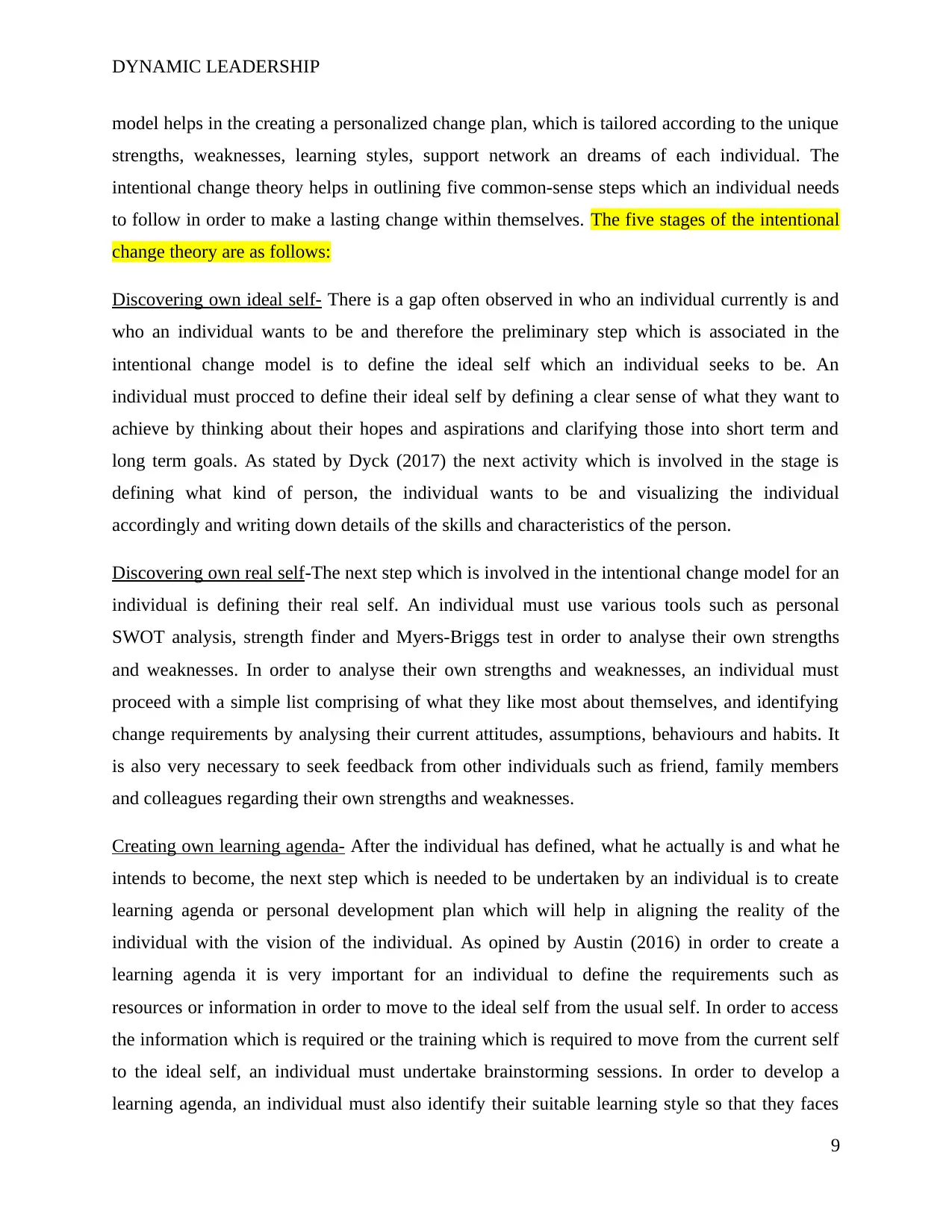
DYNAMIC LEADERSHIP
model helps in the creating a personalized change plan, which is tailored according to the unique
strengths, weaknesses, learning styles, support network an dreams of each individual. The
intentional change theory helps in outlining five common-sense steps which an individual needs
to follow in order to make a lasting change within themselves. The five stages of the intentional
change theory are as follows:
Discovering own ideal self- There is a gap often observed in who an individual currently is and
who an individual wants to be and therefore the preliminary step which is associated in the
intentional change model is to define the ideal self which an individual seeks to be. An
individual must procced to define their ideal self by defining a clear sense of what they want to
achieve by thinking about their hopes and aspirations and clarifying those into short term and
long term goals. As stated by Dyck (2017) the next activity which is involved in the stage is
defining what kind of person, the individual wants to be and visualizing the individual
accordingly and writing down details of the skills and characteristics of the person.
Discovering own real self-The next step which is involved in the intentional change model for an
individual is defining their real self. An individual must use various tools such as personal
SWOT analysis, strength finder and Myers-Briggs test in order to analyse their own strengths
and weaknesses. In order to analyse their own strengths and weaknesses, an individual must
proceed with a simple list comprising of what they like most about themselves, and identifying
change requirements by analysing their current attitudes, assumptions, behaviours and habits. It
is also very necessary to seek feedback from other individuals such as friend, family members
and colleagues regarding their own strengths and weaknesses.
Creating own learning agenda- After the individual has defined, what he actually is and what he
intends to become, the next step which is needed to be undertaken by an individual is to create
learning agenda or personal development plan which will help in aligning the reality of the
individual with the vision of the individual. As opined by Austin (2016) in order to create a
learning agenda it is very important for an individual to define the requirements such as
resources or information in order to move to the ideal self from the usual self. In order to access
the information which is required or the training which is required to move from the current self
to the ideal self, an individual must undertake brainstorming sessions. In order to develop a
learning agenda, an individual must also identify their suitable learning style so that they faces
9
model helps in the creating a personalized change plan, which is tailored according to the unique
strengths, weaknesses, learning styles, support network an dreams of each individual. The
intentional change theory helps in outlining five common-sense steps which an individual needs
to follow in order to make a lasting change within themselves. The five stages of the intentional
change theory are as follows:
Discovering own ideal self- There is a gap often observed in who an individual currently is and
who an individual wants to be and therefore the preliminary step which is associated in the
intentional change model is to define the ideal self which an individual seeks to be. An
individual must procced to define their ideal self by defining a clear sense of what they want to
achieve by thinking about their hopes and aspirations and clarifying those into short term and
long term goals. As stated by Dyck (2017) the next activity which is involved in the stage is
defining what kind of person, the individual wants to be and visualizing the individual
accordingly and writing down details of the skills and characteristics of the person.
Discovering own real self-The next step which is involved in the intentional change model for an
individual is defining their real self. An individual must use various tools such as personal
SWOT analysis, strength finder and Myers-Briggs test in order to analyse their own strengths
and weaknesses. In order to analyse their own strengths and weaknesses, an individual must
proceed with a simple list comprising of what they like most about themselves, and identifying
change requirements by analysing their current attitudes, assumptions, behaviours and habits. It
is also very necessary to seek feedback from other individuals such as friend, family members
and colleagues regarding their own strengths and weaknesses.
Creating own learning agenda- After the individual has defined, what he actually is and what he
intends to become, the next step which is needed to be undertaken by an individual is to create
learning agenda or personal development plan which will help in aligning the reality of the
individual with the vision of the individual. As opined by Austin (2016) in order to create a
learning agenda it is very important for an individual to define the requirements such as
resources or information in order to move to the ideal self from the usual self. In order to access
the information which is required or the training which is required to move from the current self
to the ideal self, an individual must undertake brainstorming sessions. In order to develop a
learning agenda, an individual must also identify their suitable learning style so that they faces
9
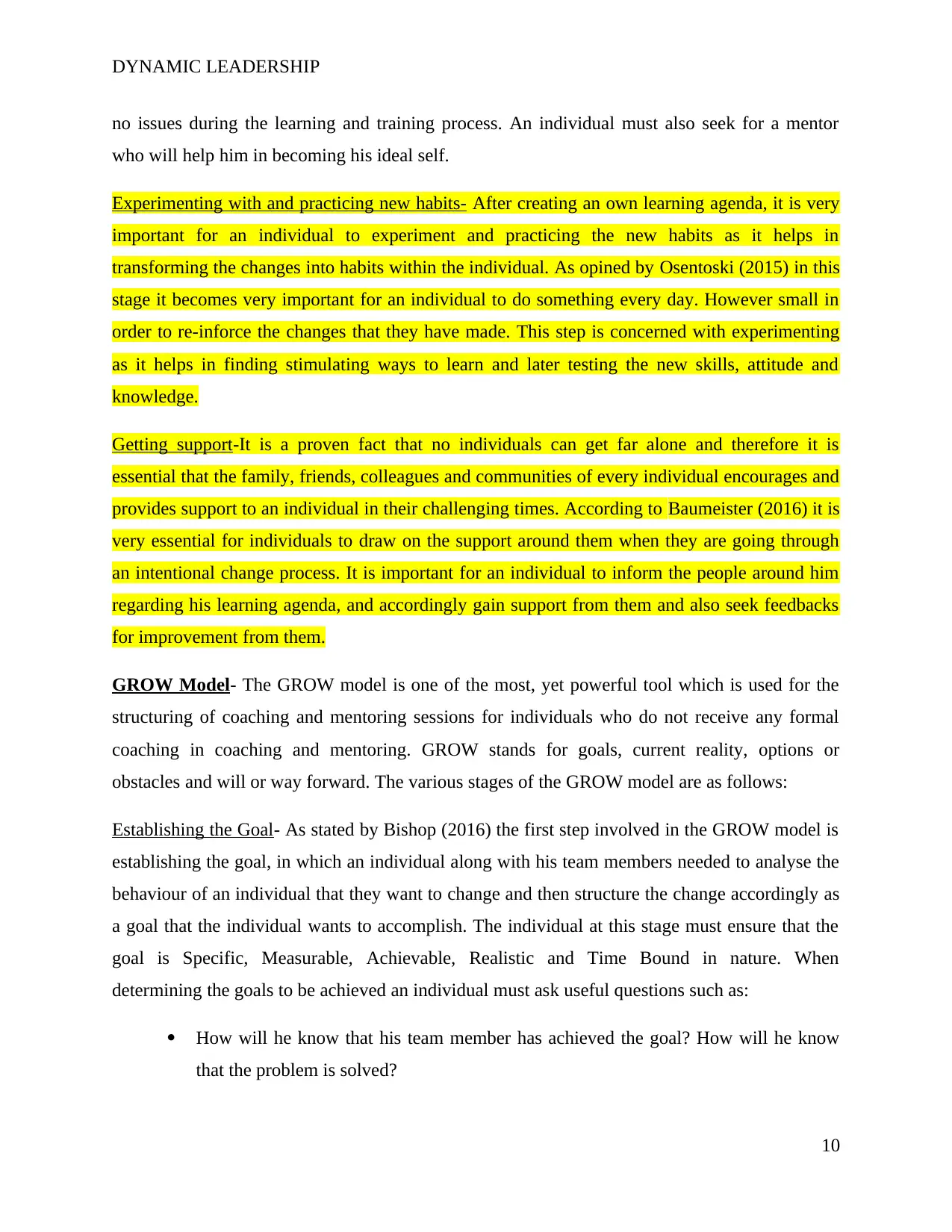
DYNAMIC LEADERSHIP
no issues during the learning and training process. An individual must also seek for a mentor
who will help him in becoming his ideal self.
Experimenting with and practicing new habits- After creating an own learning agenda, it is very
important for an individual to experiment and practicing the new habits as it helps in
transforming the changes into habits within the individual. As opined by Osentoski (2015) in this
stage it becomes very important for an individual to do something every day. However small in
order to re-inforce the changes that they have made. This step is concerned with experimenting
as it helps in finding stimulating ways to learn and later testing the new skills, attitude and
knowledge.
Getting support-It is a proven fact that no individuals can get far alone and therefore it is
essential that the family, friends, colleagues and communities of every individual encourages and
provides support to an individual in their challenging times. According to Baumeister (2016) it is
very essential for individuals to draw on the support around them when they are going through
an intentional change process. It is important for an individual to inform the people around him
regarding his learning agenda, and accordingly gain support from them and also seek feedbacks
for improvement from them.
GROW Model- The GROW model is one of the most, yet powerful tool which is used for the
structuring of coaching and mentoring sessions for individuals who do not receive any formal
coaching in coaching and mentoring. GROW stands for goals, current reality, options or
obstacles and will or way forward. The various stages of the GROW model are as follows:
Establishing the Goal- As stated by Bishop (2016) the first step involved in the GROW model is
establishing the goal, in which an individual along with his team members needed to analyse the
behaviour of an individual that they want to change and then structure the change accordingly as
a goal that the individual wants to accomplish. The individual at this stage must ensure that the
goal is Specific, Measurable, Achievable, Realistic and Time Bound in nature. When
determining the goals to be achieved an individual must ask useful questions such as:
How will he know that his team member has achieved the goal? How will he know
that the problem is solved?
10
no issues during the learning and training process. An individual must also seek for a mentor
who will help him in becoming his ideal self.
Experimenting with and practicing new habits- After creating an own learning agenda, it is very
important for an individual to experiment and practicing the new habits as it helps in
transforming the changes into habits within the individual. As opined by Osentoski (2015) in this
stage it becomes very important for an individual to do something every day. However small in
order to re-inforce the changes that they have made. This step is concerned with experimenting
as it helps in finding stimulating ways to learn and later testing the new skills, attitude and
knowledge.
Getting support-It is a proven fact that no individuals can get far alone and therefore it is
essential that the family, friends, colleagues and communities of every individual encourages and
provides support to an individual in their challenging times. According to Baumeister (2016) it is
very essential for individuals to draw on the support around them when they are going through
an intentional change process. It is important for an individual to inform the people around him
regarding his learning agenda, and accordingly gain support from them and also seek feedbacks
for improvement from them.
GROW Model- The GROW model is one of the most, yet powerful tool which is used for the
structuring of coaching and mentoring sessions for individuals who do not receive any formal
coaching in coaching and mentoring. GROW stands for goals, current reality, options or
obstacles and will or way forward. The various stages of the GROW model are as follows:
Establishing the Goal- As stated by Bishop (2016) the first step involved in the GROW model is
establishing the goal, in which an individual along with his team members needed to analyse the
behaviour of an individual that they want to change and then structure the change accordingly as
a goal that the individual wants to accomplish. The individual at this stage must ensure that the
goal is Specific, Measurable, Achievable, Realistic and Time Bound in nature. When
determining the goals to be achieved an individual must ask useful questions such as:
How will he know that his team member has achieved the goal? How will he know
that the problem is solved?
10
Secure Best Marks with AI Grader
Need help grading? Try our AI Grader for instant feedback on your assignments.
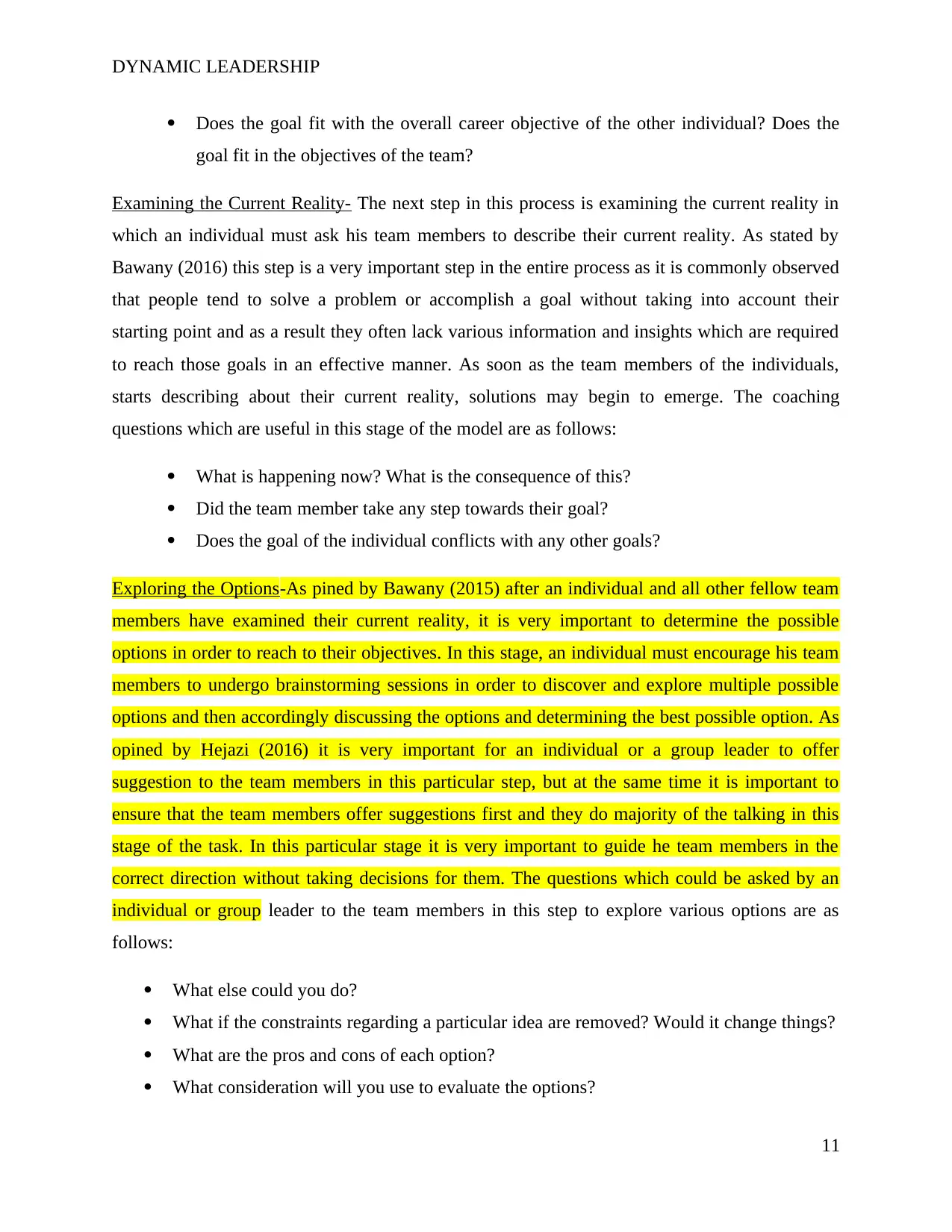
DYNAMIC LEADERSHIP
Does the goal fit with the overall career objective of the other individual? Does the
goal fit in the objectives of the team?
Examining the Current Reality- The next step in this process is examining the current reality in
which an individual must ask his team members to describe their current reality. As stated by
Bawany (2016) this step is a very important step in the entire process as it is commonly observed
that people tend to solve a problem or accomplish a goal without taking into account their
starting point and as a result they often lack various information and insights which are required
to reach those goals in an effective manner. As soon as the team members of the individuals,
starts describing about their current reality, solutions may begin to emerge. The coaching
questions which are useful in this stage of the model are as follows:
What is happening now? What is the consequence of this?
Did the team member take any step towards their goal?
Does the goal of the individual conflicts with any other goals?
Exploring the Options-As pined by Bawany (2015) after an individual and all other fellow team
members have examined their current reality, it is very important to determine the possible
options in order to reach to their objectives. In this stage, an individual must encourage his team
members to undergo brainstorming sessions in order to discover and explore multiple possible
options and then accordingly discussing the options and determining the best possible option. As
opined by Hejazi (2016) it is very important for an individual or a group leader to offer
suggestion to the team members in this particular step, but at the same time it is important to
ensure that the team members offer suggestions first and they do majority of the talking in this
stage of the task. In this particular stage it is very important to guide he team members in the
correct direction without taking decisions for them. The questions which could be asked by an
individual or group leader to the team members in this step to explore various options are as
follows:
What else could you do?
What if the constraints regarding a particular idea are removed? Would it change things?
What are the pros and cons of each option?
What consideration will you use to evaluate the options?
11
Does the goal fit with the overall career objective of the other individual? Does the
goal fit in the objectives of the team?
Examining the Current Reality- The next step in this process is examining the current reality in
which an individual must ask his team members to describe their current reality. As stated by
Bawany (2016) this step is a very important step in the entire process as it is commonly observed
that people tend to solve a problem or accomplish a goal without taking into account their
starting point and as a result they often lack various information and insights which are required
to reach those goals in an effective manner. As soon as the team members of the individuals,
starts describing about their current reality, solutions may begin to emerge. The coaching
questions which are useful in this stage of the model are as follows:
What is happening now? What is the consequence of this?
Did the team member take any step towards their goal?
Does the goal of the individual conflicts with any other goals?
Exploring the Options-As pined by Bawany (2015) after an individual and all other fellow team
members have examined their current reality, it is very important to determine the possible
options in order to reach to their objectives. In this stage, an individual must encourage his team
members to undergo brainstorming sessions in order to discover and explore multiple possible
options and then accordingly discussing the options and determining the best possible option. As
opined by Hejazi (2016) it is very important for an individual or a group leader to offer
suggestion to the team members in this particular step, but at the same time it is important to
ensure that the team members offer suggestions first and they do majority of the talking in this
stage of the task. In this particular stage it is very important to guide he team members in the
correct direction without taking decisions for them. The questions which could be asked by an
individual or group leader to the team members in this step to explore various options are as
follows:
What else could you do?
What if the constraints regarding a particular idea are removed? Would it change things?
What are the pros and cons of each option?
What consideration will you use to evaluate the options?
11

DYNAMIC LEADERSHIP
What obstacles are in front of you?
What do you need to stop doing in order to achieve the goals?
Establishing the Will-As stated by Casey & Wuestman (2015) after the analysis of the current
reality and after exploring the possible options, the team members can gain great ideas regarding
achievement of their goals but still the goals of the team members cannot be achieved if the team
members fail to commit to various specific actions in order to move forward towards achieving
their goal and therefore it is very important for team members to commit to various specific
actions in order to move forward towards achieving their goal in order to help the team embers
establish their will and boost their motivation. The questions which can be asked by an
individual or a group leader to the team members in this stage are as follows:
When and what will you do now? What else do you plan to do?
What could prevent you from moving forward and how will you overcome it?
How can you keep yourself self-motivated all the time?
When do you require evaluating your progress?
After undertaking specific ways to accomplish their objectives, an individual or a group leader
must decide a date with the team members in order to evaluate their progress which will provide
some accountability and will enable the team members to modify their actions if their default
plan is not working effectively.
Based on the above discussions and review of the above three leadership development model, I
would select the Johari Window, as the model for my personal development as the Johari
Window Model is an effective model which can be used for understanding and training of self-
awareness, personal development, improving communication, inter-personal relationships, group
dynamics, team development and inter-group relationships. As stated by Hinner (2016) in
addition to the above mentioned factors there are several other reasons for choosing Johari
Window, as my leadership development model such as this model is easy to gasp and it also
facilitates expected outcomes, this model helps in facilitating open information sharing and this
method helps in creating a shared reference point.
As stated by Pekeur (2014) the main reasons for not selecting the intentional change model and
the GROW model is because both the models helps in facilitating changes among individuals but
12
What obstacles are in front of you?
What do you need to stop doing in order to achieve the goals?
Establishing the Will-As stated by Casey & Wuestman (2015) after the analysis of the current
reality and after exploring the possible options, the team members can gain great ideas regarding
achievement of their goals but still the goals of the team members cannot be achieved if the team
members fail to commit to various specific actions in order to move forward towards achieving
their goal and therefore it is very important for team members to commit to various specific
actions in order to move forward towards achieving their goal in order to help the team embers
establish their will and boost their motivation. The questions which can be asked by an
individual or a group leader to the team members in this stage are as follows:
When and what will you do now? What else do you plan to do?
What could prevent you from moving forward and how will you overcome it?
How can you keep yourself self-motivated all the time?
When do you require evaluating your progress?
After undertaking specific ways to accomplish their objectives, an individual or a group leader
must decide a date with the team members in order to evaluate their progress which will provide
some accountability and will enable the team members to modify their actions if their default
plan is not working effectively.
Based on the above discussions and review of the above three leadership development model, I
would select the Johari Window, as the model for my personal development as the Johari
Window Model is an effective model which can be used for understanding and training of self-
awareness, personal development, improving communication, inter-personal relationships, group
dynamics, team development and inter-group relationships. As stated by Hinner (2016) in
addition to the above mentioned factors there are several other reasons for choosing Johari
Window, as my leadership development model such as this model is easy to gasp and it also
facilitates expected outcomes, this model helps in facilitating open information sharing and this
method helps in creating a shared reference point.
As stated by Pekeur (2014) the main reasons for not selecting the intentional change model and
the GROW model is because both the models helps in facilitating changes among individuals but
12
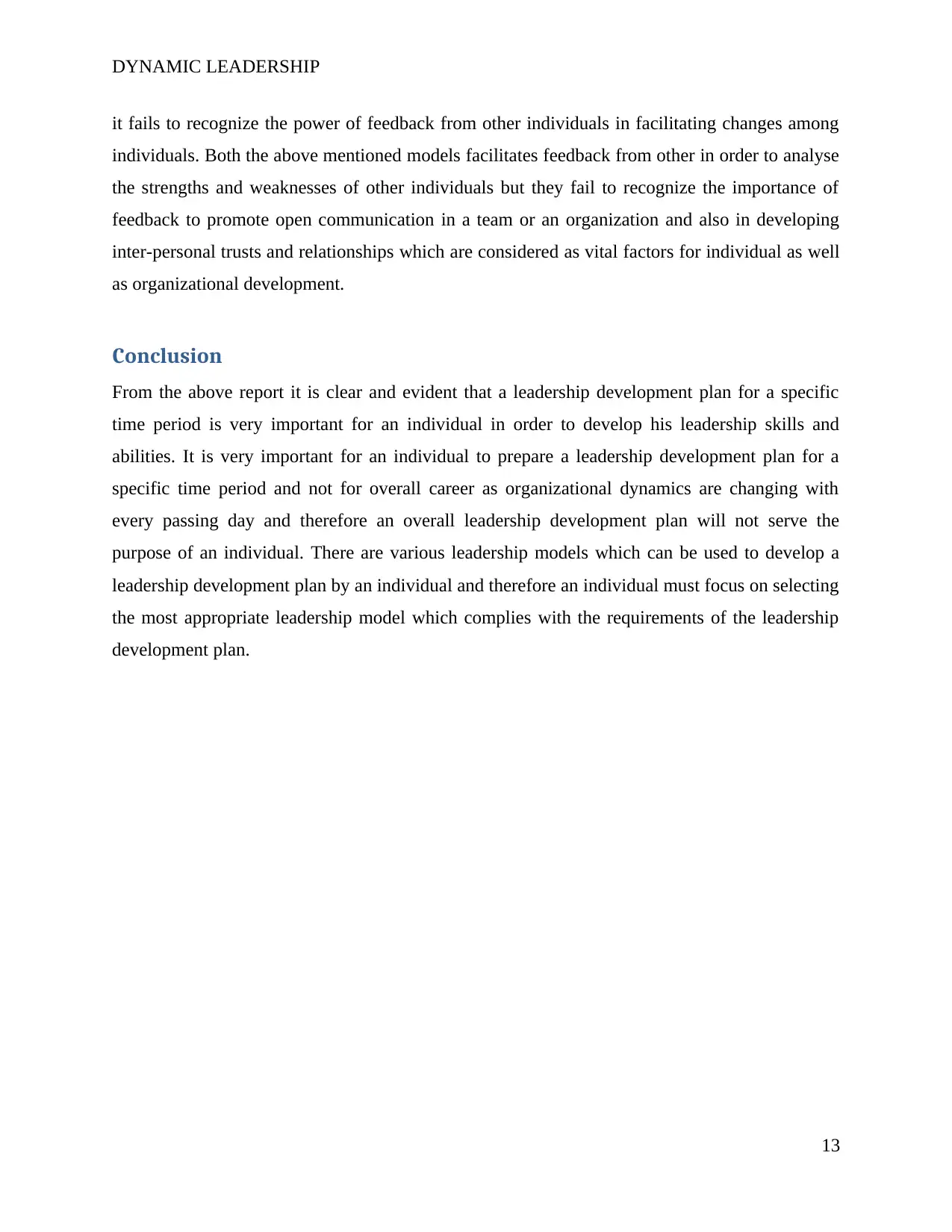
DYNAMIC LEADERSHIP
it fails to recognize the power of feedback from other individuals in facilitating changes among
individuals. Both the above mentioned models facilitates feedback from other in order to analyse
the strengths and weaknesses of other individuals but they fail to recognize the importance of
feedback to promote open communication in a team or an organization and also in developing
inter-personal trusts and relationships which are considered as vital factors for individual as well
as organizational development.
Conclusion
From the above report it is clear and evident that a leadership development plan for a specific
time period is very important for an individual in order to develop his leadership skills and
abilities. It is very important for an individual to prepare a leadership development plan for a
specific time period and not for overall career as organizational dynamics are changing with
every passing day and therefore an overall leadership development plan will not serve the
purpose of an individual. There are various leadership models which can be used to develop a
leadership development plan by an individual and therefore an individual must focus on selecting
the most appropriate leadership model which complies with the requirements of the leadership
development plan.
13
it fails to recognize the power of feedback from other individuals in facilitating changes among
individuals. Both the above mentioned models facilitates feedback from other in order to analyse
the strengths and weaknesses of other individuals but they fail to recognize the importance of
feedback to promote open communication in a team or an organization and also in developing
inter-personal trusts and relationships which are considered as vital factors for individual as well
as organizational development.
Conclusion
From the above report it is clear and evident that a leadership development plan for a specific
time period is very important for an individual in order to develop his leadership skills and
abilities. It is very important for an individual to prepare a leadership development plan for a
specific time period and not for overall career as organizational dynamics are changing with
every passing day and therefore an overall leadership development plan will not serve the
purpose of an individual. There are various leadership models which can be used to develop a
leadership development plan by an individual and therefore an individual must focus on selecting
the most appropriate leadership model which complies with the requirements of the leadership
development plan.
13
Paraphrase This Document
Need a fresh take? Get an instant paraphrase of this document with our AI Paraphraser
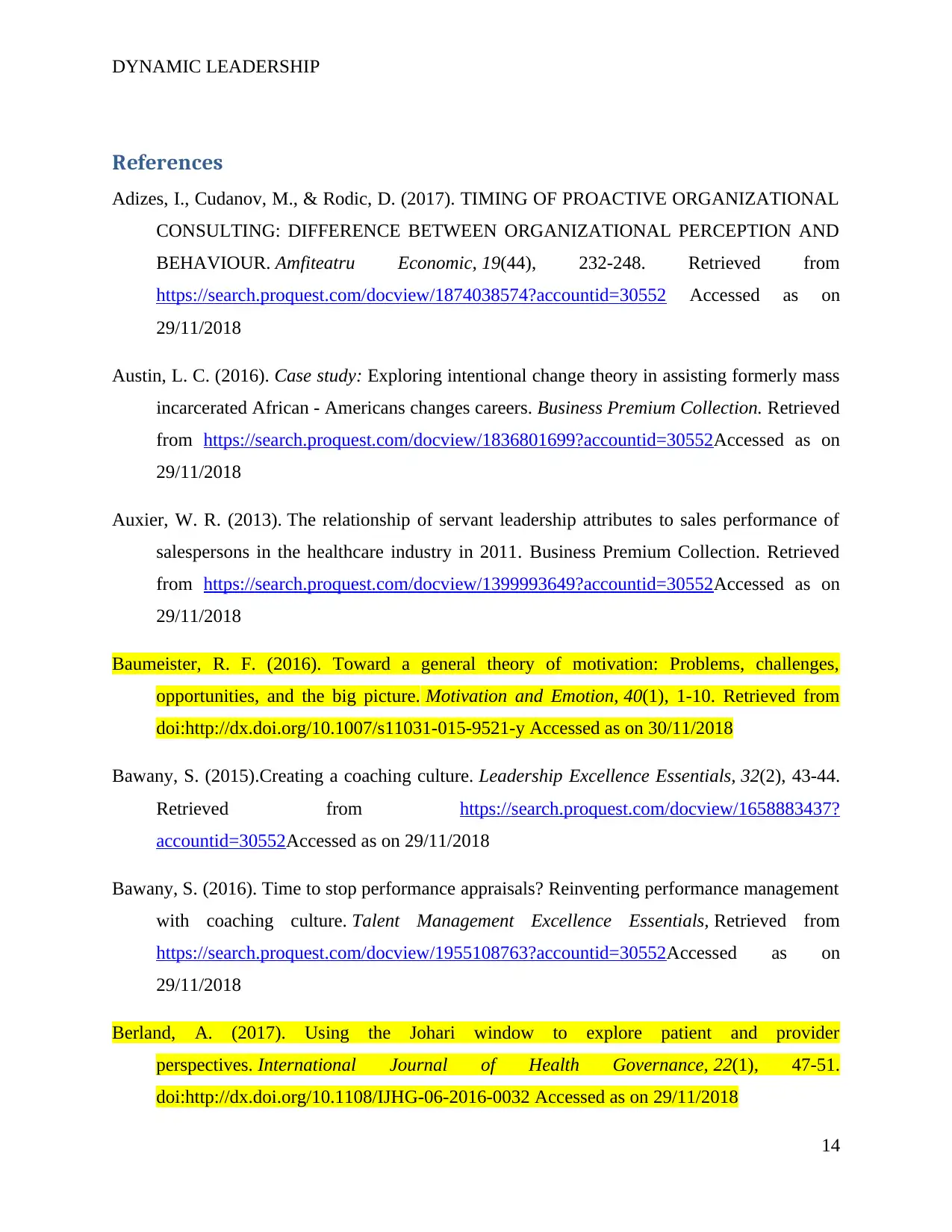
DYNAMIC LEADERSHIP
References
Adizes, I., Cudanov, M., & Rodic, D. (2017). TIMING OF PROACTIVE ORGANIZATIONAL
CONSULTING: DIFFERENCE BETWEEN ORGANIZATIONAL PERCEPTION AND
BEHAVIOUR. Amfiteatru Economic, 19(44), 232-248. Retrieved from
https://search.proquest.com/docview/1874038574?accountid=30552 Accessed as on
29/11/2018
Austin, L. C. (2016). Case study: Exploring intentional change theory in assisting formerly mass
incarcerated African - Americans changes careers. Business Premium Collection. Retrieved
from https://search.proquest.com/docview/1836801699?accountid=30552Accessed as on
29/11/2018
Auxier, W. R. (2013). The relationship of servant leadership attributes to sales performance of
salespersons in the healthcare industry in 2011. Business Premium Collection. Retrieved
from https://search.proquest.com/docview/1399993649?accountid=30552Accessed as on
29/11/2018
Baumeister, R. F. (2016). Toward a general theory of motivation: Problems, challenges,
opportunities, and the big picture. Motivation and Emotion, 40(1), 1-10. Retrieved from
doi:http://dx.doi.org/10.1007/s11031-015-9521-y Accessed as on 30/11/2018
Bawany, S. (2015).Creating a coaching culture. Leadership Excellence Essentials, 32(2), 43-44.
Retrieved from https://search.proquest.com/docview/1658883437?
accountid=30552Accessed as on 29/11/2018
Bawany, S. (2016). Time to stop performance appraisals? Reinventing performance management
with coaching culture. Talent Management Excellence Essentials, Retrieved from
https://search.proquest.com/docview/1955108763?accountid=30552Accessed as on
29/11/2018
Berland, A. (2017). Using the Johari window to explore patient and provider
perspectives. International Journal of Health Governance, 22(1), 47-51.
doi:http://dx.doi.org/10.1108/IJHG-06-2016-0032 Accessed as on 29/11/2018
14
References
Adizes, I., Cudanov, M., & Rodic, D. (2017). TIMING OF PROACTIVE ORGANIZATIONAL
CONSULTING: DIFFERENCE BETWEEN ORGANIZATIONAL PERCEPTION AND
BEHAVIOUR. Amfiteatru Economic, 19(44), 232-248. Retrieved from
https://search.proquest.com/docview/1874038574?accountid=30552 Accessed as on
29/11/2018
Austin, L. C. (2016). Case study: Exploring intentional change theory in assisting formerly mass
incarcerated African - Americans changes careers. Business Premium Collection. Retrieved
from https://search.proquest.com/docview/1836801699?accountid=30552Accessed as on
29/11/2018
Auxier, W. R. (2013). The relationship of servant leadership attributes to sales performance of
salespersons in the healthcare industry in 2011. Business Premium Collection. Retrieved
from https://search.proquest.com/docview/1399993649?accountid=30552Accessed as on
29/11/2018
Baumeister, R. F. (2016). Toward a general theory of motivation: Problems, challenges,
opportunities, and the big picture. Motivation and Emotion, 40(1), 1-10. Retrieved from
doi:http://dx.doi.org/10.1007/s11031-015-9521-y Accessed as on 30/11/2018
Bawany, S. (2015).Creating a coaching culture. Leadership Excellence Essentials, 32(2), 43-44.
Retrieved from https://search.proquest.com/docview/1658883437?
accountid=30552Accessed as on 29/11/2018
Bawany, S. (2016). Time to stop performance appraisals? Reinventing performance management
with coaching culture. Talent Management Excellence Essentials, Retrieved from
https://search.proquest.com/docview/1955108763?accountid=30552Accessed as on
29/11/2018
Berland, A. (2017). Using the Johari window to explore patient and provider
perspectives. International Journal of Health Governance, 22(1), 47-51.
doi:http://dx.doi.org/10.1108/IJHG-06-2016-0032 Accessed as on 29/11/2018
14
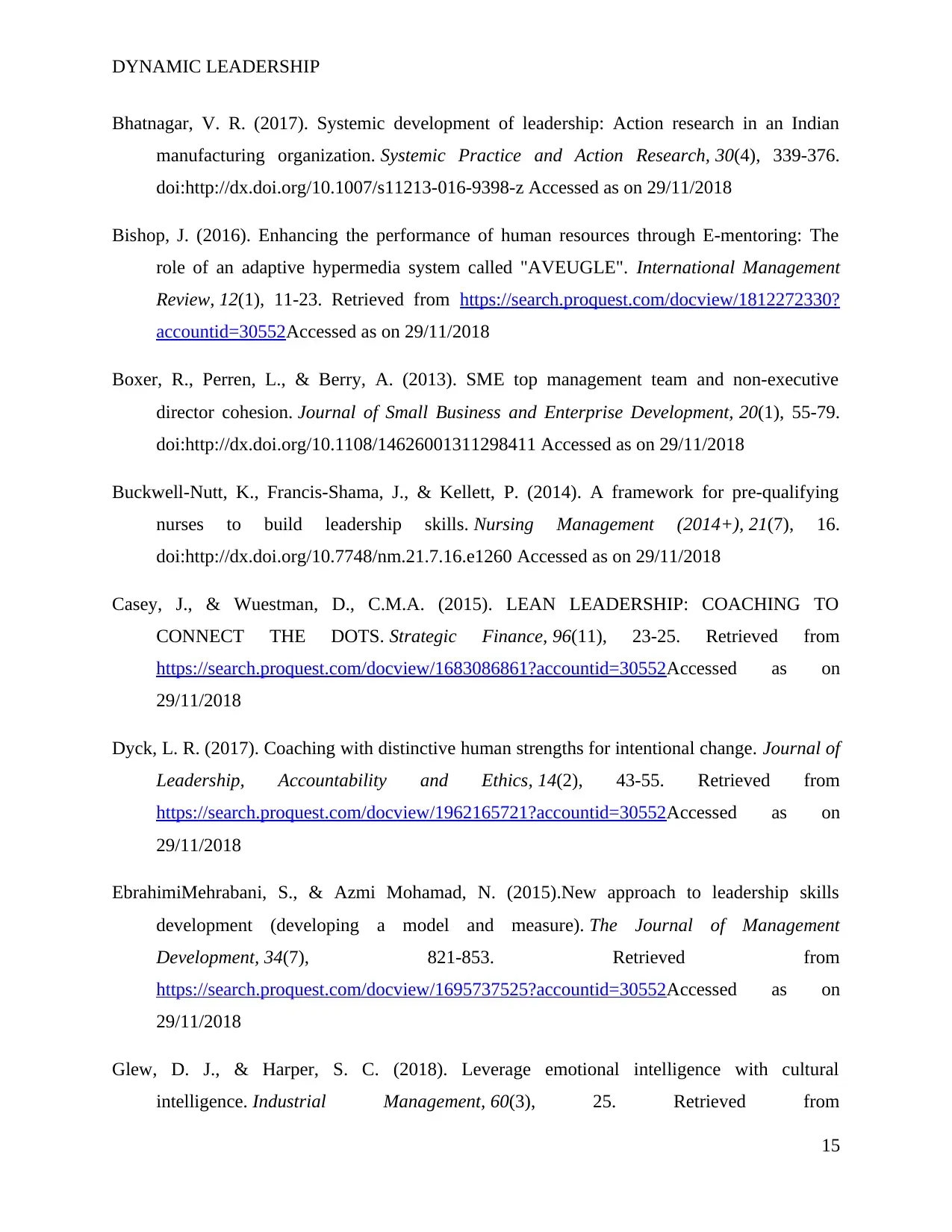
DYNAMIC LEADERSHIP
Bhatnagar, V. R. (2017). Systemic development of leadership: Action research in an Indian
manufacturing organization. Systemic Practice and Action Research, 30(4), 339-376.
doi:http://dx.doi.org/10.1007/s11213-016-9398-z Accessed as on 29/11/2018
Bishop, J. (2016). Enhancing the performance of human resources through E-mentoring: The
role of an adaptive hypermedia system called "AVEUGLE". International Management
Review, 12(1), 11-23. Retrieved from https://search.proquest.com/docview/1812272330?
accountid=30552Accessed as on 29/11/2018
Boxer, R., Perren, L., & Berry, A. (2013). SME top management team and non-executive
director cohesion. Journal of Small Business and Enterprise Development, 20(1), 55-79.
doi:http://dx.doi.org/10.1108/14626001311298411 Accessed as on 29/11/2018
Buckwell-Nutt, K., Francis-Shama, J., & Kellett, P. (2014). A framework for pre-qualifying
nurses to build leadership skills. Nursing Management (2014+), 21(7), 16.
doi:http://dx.doi.org/10.7748/nm.21.7.16.e1260 Accessed as on 29/11/2018
Casey, J., & Wuestman, D., C.M.A. (2015). LEAN LEADERSHIP: COACHING TO
CONNECT THE DOTS. Strategic Finance, 96(11), 23-25. Retrieved from
https://search.proquest.com/docview/1683086861?accountid=30552Accessed as on
29/11/2018
Dyck, L. R. (2017). Coaching with distinctive human strengths for intentional change. Journal of
Leadership, Accountability and Ethics, 14(2), 43-55. Retrieved from
https://search.proquest.com/docview/1962165721?accountid=30552Accessed as on
29/11/2018
EbrahimiMehrabani, S., & Azmi Mohamad, N. (2015).New approach to leadership skills
development (developing a model and measure). The Journal of Management
Development, 34(7), 821-853. Retrieved from
https://search.proquest.com/docview/1695737525?accountid=30552Accessed as on
29/11/2018
Glew, D. J., & Harper, S. C. (2018). Leverage emotional intelligence with cultural
intelligence. Industrial Management, 60(3), 25. Retrieved from
15
Bhatnagar, V. R. (2017). Systemic development of leadership: Action research in an Indian
manufacturing organization. Systemic Practice and Action Research, 30(4), 339-376.
doi:http://dx.doi.org/10.1007/s11213-016-9398-z Accessed as on 29/11/2018
Bishop, J. (2016). Enhancing the performance of human resources through E-mentoring: The
role of an adaptive hypermedia system called "AVEUGLE". International Management
Review, 12(1), 11-23. Retrieved from https://search.proquest.com/docview/1812272330?
accountid=30552Accessed as on 29/11/2018
Boxer, R., Perren, L., & Berry, A. (2013). SME top management team and non-executive
director cohesion. Journal of Small Business and Enterprise Development, 20(1), 55-79.
doi:http://dx.doi.org/10.1108/14626001311298411 Accessed as on 29/11/2018
Buckwell-Nutt, K., Francis-Shama, J., & Kellett, P. (2014). A framework for pre-qualifying
nurses to build leadership skills. Nursing Management (2014+), 21(7), 16.
doi:http://dx.doi.org/10.7748/nm.21.7.16.e1260 Accessed as on 29/11/2018
Casey, J., & Wuestman, D., C.M.A. (2015). LEAN LEADERSHIP: COACHING TO
CONNECT THE DOTS. Strategic Finance, 96(11), 23-25. Retrieved from
https://search.proquest.com/docview/1683086861?accountid=30552Accessed as on
29/11/2018
Dyck, L. R. (2017). Coaching with distinctive human strengths for intentional change. Journal of
Leadership, Accountability and Ethics, 14(2), 43-55. Retrieved from
https://search.proquest.com/docview/1962165721?accountid=30552Accessed as on
29/11/2018
EbrahimiMehrabani, S., & Azmi Mohamad, N. (2015).New approach to leadership skills
development (developing a model and measure). The Journal of Management
Development, 34(7), 821-853. Retrieved from
https://search.proquest.com/docview/1695737525?accountid=30552Accessed as on
29/11/2018
Glew, D. J., & Harper, S. C. (2018). Leverage emotional intelligence with cultural
intelligence. Industrial Management, 60(3), 25. Retrieved from
15
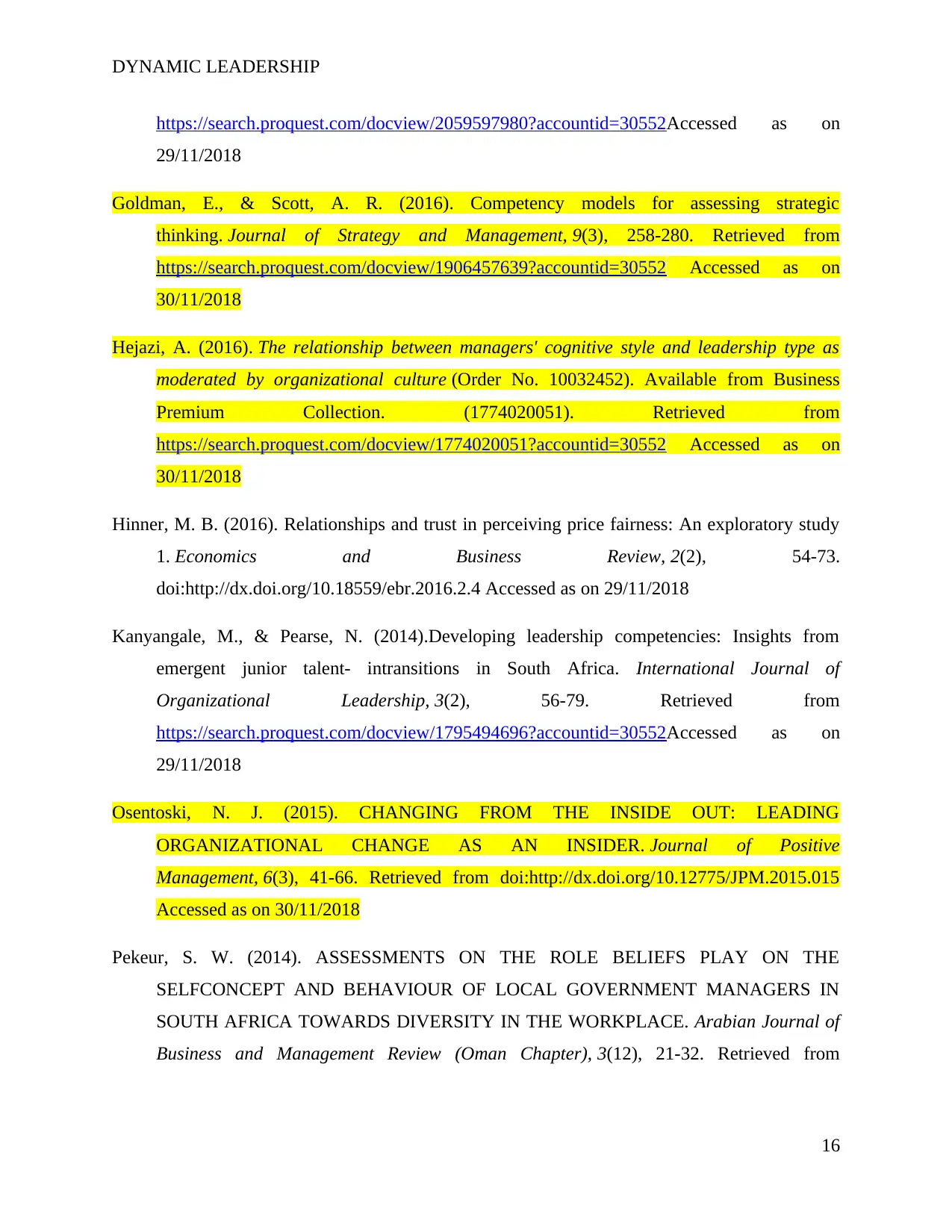
DYNAMIC LEADERSHIP
https://search.proquest.com/docview/2059597980?accountid=30552Accessed as on
29/11/2018
Goldman, E., & Scott, A. R. (2016). Competency models for assessing strategic
thinking. Journal of Strategy and Management, 9(3), 258-280. Retrieved from
https://search.proquest.com/docview/1906457639?accountid=30552 Accessed as on
30/11/2018
Hejazi, A. (2016). The relationship between managers' cognitive style and leadership type as
moderated by organizational culture (Order No. 10032452). Available from Business
Premium Collection. (1774020051). Retrieved from
https://search.proquest.com/docview/1774020051?accountid=30552 Accessed as on
30/11/2018
Hinner, M. B. (2016). Relationships and trust in perceiving price fairness: An exploratory study
1. Economics and Business Review, 2(2), 54-73.
doi:http://dx.doi.org/10.18559/ebr.2016.2.4 Accessed as on 29/11/2018
Kanyangale, M., & Pearse, N. (2014).Developing leadership competencies: Insights from
emergent junior talent- intransitions in South Africa. International Journal of
Organizational Leadership, 3(2), 56-79. Retrieved from
https://search.proquest.com/docview/1795494696?accountid=30552Accessed as on
29/11/2018
Osentoski, N. J. (2015). CHANGING FROM THE INSIDE OUT: LEADING
ORGANIZATIONAL CHANGE AS AN INSIDER. Journal of Positive
Management, 6(3), 41-66. Retrieved from doi:http://dx.doi.org/10.12775/JPM.2015.015
Accessed as on 30/11/2018
Pekeur, S. W. (2014). ASSESSMENTS ON THE ROLE BELIEFS PLAY ON THE
SELFCONCEPT AND BEHAVIOUR OF LOCAL GOVERNMENT MANAGERS IN
SOUTH AFRICA TOWARDS DIVERSITY IN THE WORKPLACE. Arabian Journal of
Business and Management Review (Oman Chapter), 3(12), 21-32. Retrieved from
16
https://search.proquest.com/docview/2059597980?accountid=30552Accessed as on
29/11/2018
Goldman, E., & Scott, A. R. (2016). Competency models for assessing strategic
thinking. Journal of Strategy and Management, 9(3), 258-280. Retrieved from
https://search.proquest.com/docview/1906457639?accountid=30552 Accessed as on
30/11/2018
Hejazi, A. (2016). The relationship between managers' cognitive style and leadership type as
moderated by organizational culture (Order No. 10032452). Available from Business
Premium Collection. (1774020051). Retrieved from
https://search.proquest.com/docview/1774020051?accountid=30552 Accessed as on
30/11/2018
Hinner, M. B. (2016). Relationships and trust in perceiving price fairness: An exploratory study
1. Economics and Business Review, 2(2), 54-73.
doi:http://dx.doi.org/10.18559/ebr.2016.2.4 Accessed as on 29/11/2018
Kanyangale, M., & Pearse, N. (2014).Developing leadership competencies: Insights from
emergent junior talent- intransitions in South Africa. International Journal of
Organizational Leadership, 3(2), 56-79. Retrieved from
https://search.proquest.com/docview/1795494696?accountid=30552Accessed as on
29/11/2018
Osentoski, N. J. (2015). CHANGING FROM THE INSIDE OUT: LEADING
ORGANIZATIONAL CHANGE AS AN INSIDER. Journal of Positive
Management, 6(3), 41-66. Retrieved from doi:http://dx.doi.org/10.12775/JPM.2015.015
Accessed as on 30/11/2018
Pekeur, S. W. (2014). ASSESSMENTS ON THE ROLE BELIEFS PLAY ON THE
SELFCONCEPT AND BEHAVIOUR OF LOCAL GOVERNMENT MANAGERS IN
SOUTH AFRICA TOWARDS DIVERSITY IN THE WORKPLACE. Arabian Journal of
Business and Management Review (Oman Chapter), 3(12), 21-32. Retrieved from
16
Secure Best Marks with AI Grader
Need help grading? Try our AI Grader for instant feedback on your assignments.
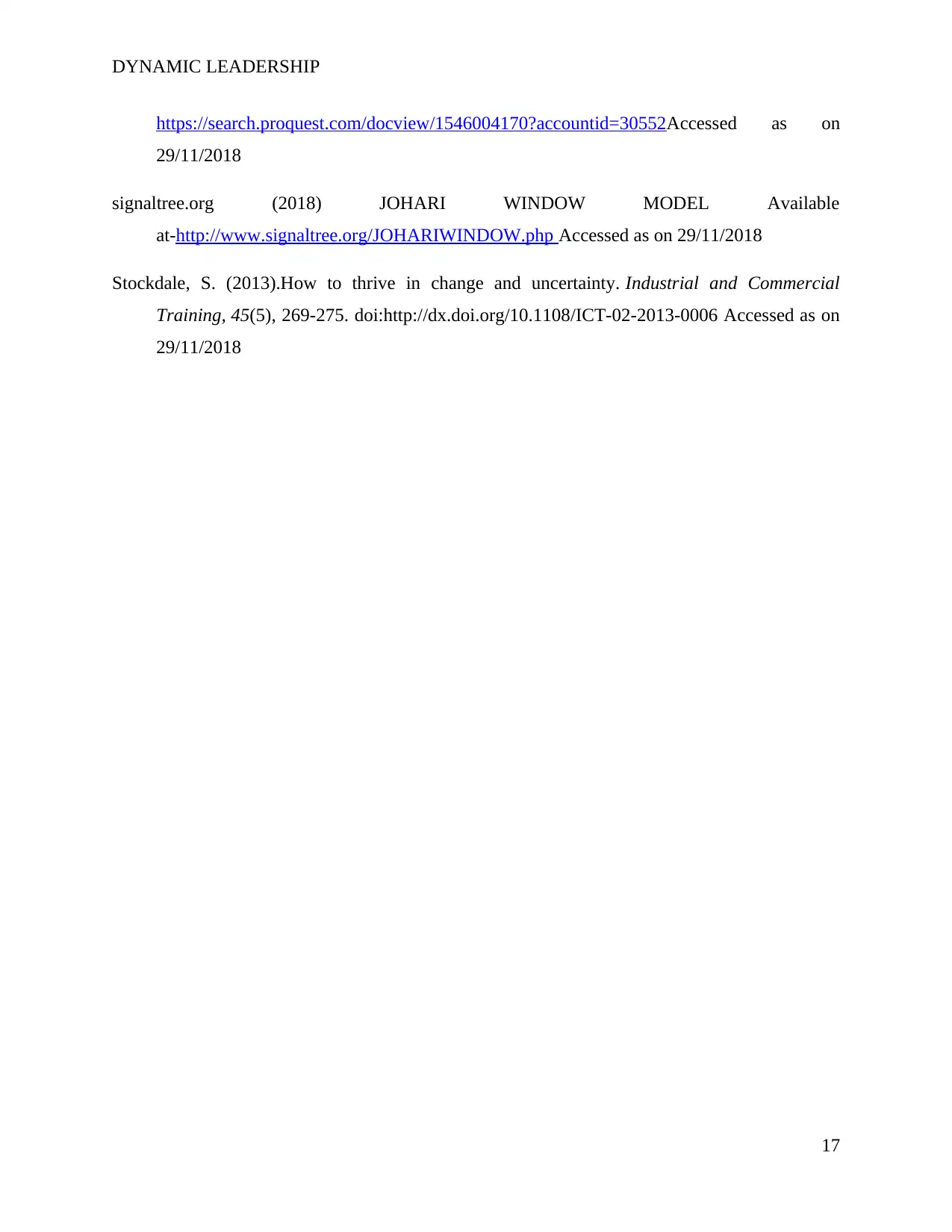
DYNAMIC LEADERSHIP
https://search.proquest.com/docview/1546004170?accountid=30552Accessed as on
29/11/2018
signaltree.org (2018) JOHARI WINDOW MODEL Available
at-http://www.signaltree.org/JOHARIWINDOW.php Accessed as on 29/11/2018
Stockdale, S. (2013).How to thrive in change and uncertainty. Industrial and Commercial
Training, 45(5), 269-275. doi:http://dx.doi.org/10.1108/ICT-02-2013-0006 Accessed as on
29/11/2018
17
https://search.proquest.com/docview/1546004170?accountid=30552Accessed as on
29/11/2018
signaltree.org (2018) JOHARI WINDOW MODEL Available
at-http://www.signaltree.org/JOHARIWINDOW.php Accessed as on 29/11/2018
Stockdale, S. (2013).How to thrive in change and uncertainty. Industrial and Commercial
Training, 45(5), 269-275. doi:http://dx.doi.org/10.1108/ICT-02-2013-0006 Accessed as on
29/11/2018
17
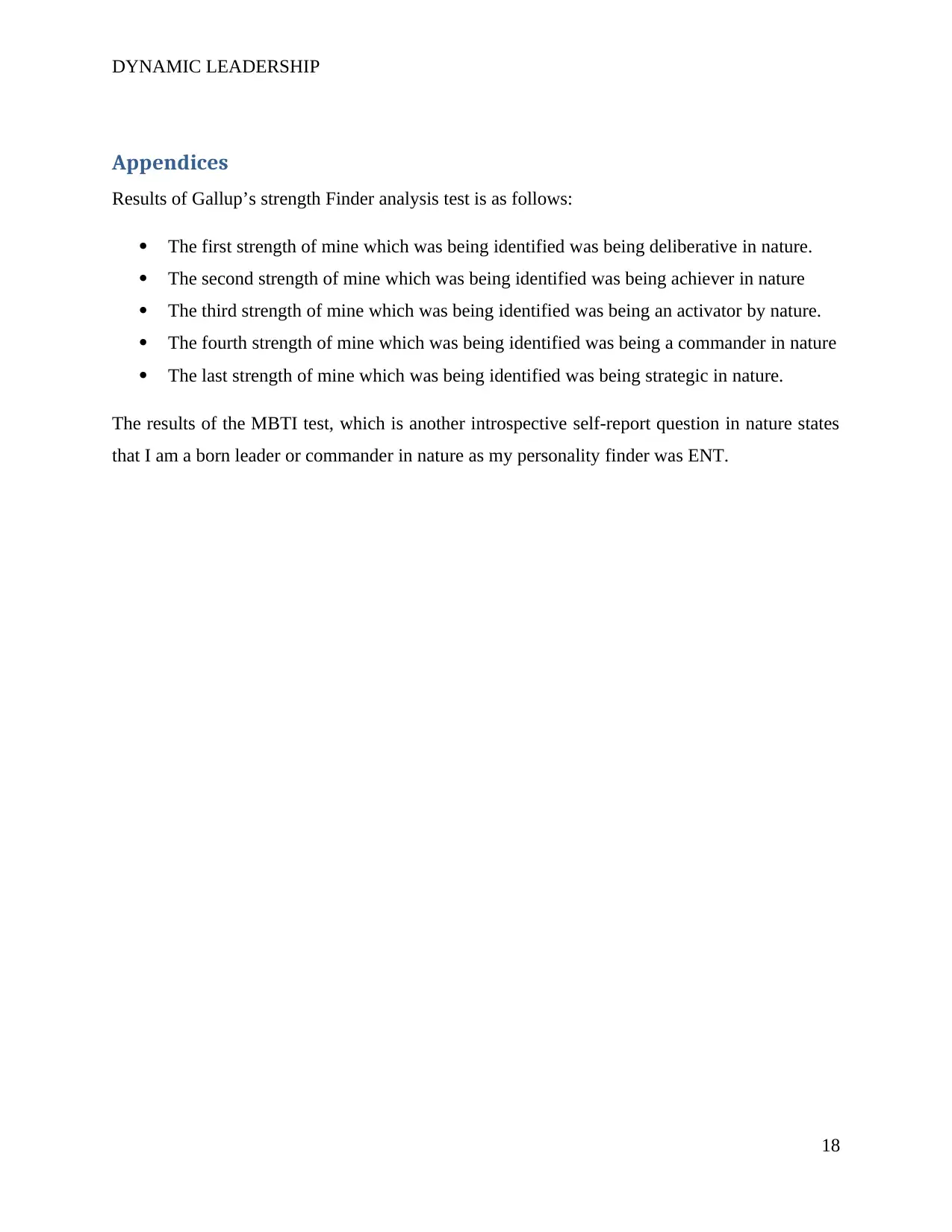
DYNAMIC LEADERSHIP
Appendices
Results of Gallup’s strength Finder analysis test is as follows:
The first strength of mine which was being identified was being deliberative in nature.
The second strength of mine which was being identified was being achiever in nature
The third strength of mine which was being identified was being an activator by nature.
The fourth strength of mine which was being identified was being a commander in nature
The last strength of mine which was being identified was being strategic in nature.
The results of the MBTI test, which is another introspective self-report question in nature states
that I am a born leader or commander in nature as my personality finder was ENT.
18
Appendices
Results of Gallup’s strength Finder analysis test is as follows:
The first strength of mine which was being identified was being deliberative in nature.
The second strength of mine which was being identified was being achiever in nature
The third strength of mine which was being identified was being an activator by nature.
The fourth strength of mine which was being identified was being a commander in nature
The last strength of mine which was being identified was being strategic in nature.
The results of the MBTI test, which is another introspective self-report question in nature states
that I am a born leader or commander in nature as my personality finder was ENT.
18
1 out of 18
Related Documents
Your All-in-One AI-Powered Toolkit for Academic Success.
+13062052269
info@desklib.com
Available 24*7 on WhatsApp / Email
![[object Object]](/_next/static/media/star-bottom.7253800d.svg)
Unlock your academic potential
© 2024 | Zucol Services PVT LTD | All rights reserved.





